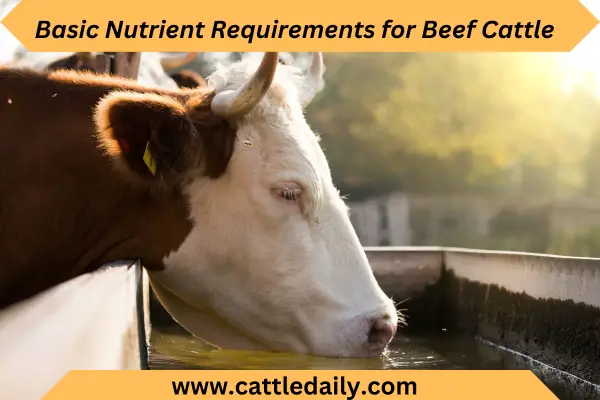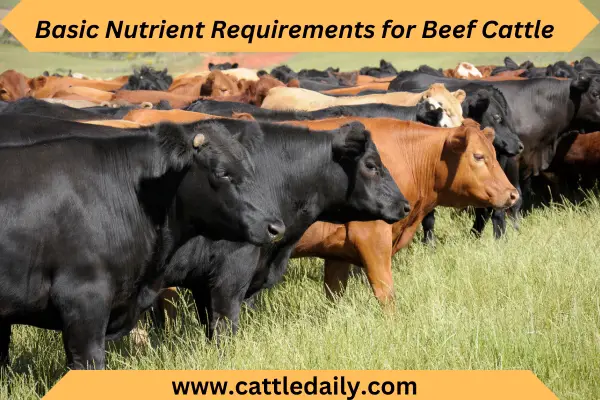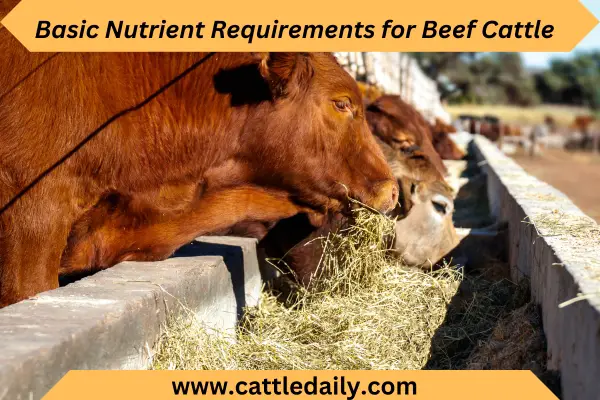Basic Nutrient Requirements for Beef Cattle
Raising healthy and productive beef cattle requires meeting their basic nutritional needs. Cattle nutrition is complex, but understanding beef cattle’s fundamental nutrient requirements can help producers formulate optimal rations.
In this blog article, we will provide an overview of the basic nutritional requirements for beef cattle and critical considerations for meeting them.
1. Energy Requirements
Energy is the most essential nutrient for beef cattle growth and performance. The primary energy sources in cattle diets are carbohydrates and fats.
Energy requirements depend on the animal’s physiological state, with growing, lactating, and heavily pregnant cattle needing more energy than mature, non-lactating cattle.
The energy requirements are commonly expressed as Total Digestible Nutrients (TDN). TDN intake recommendations for beef cattle range from 7.5% of body weight for mature cows to 9.5% for growing calves. Energy can be supplied through forages and concentrates. High-energy feedstuffs include grains like corn, barley, and oats.
2. Protein Requirements
Dietary protein provides essential amino acids and nitrogen needed for muscle growth and development in cattle. The crude protein (CP) requirements vary with age, size, growth rate, and production stage.
For example, growing calves need 12-14% CP in their diet dry matter, while mature cows only need 7-9% CP.
The CP should contain adequate levels of rumen degradable protein (RDP) for rumen microbial protein synthesis and rumen undegradable protein (RUP) to meet the animal’s amino acid needs. Joint protein supplements are oilseed meals, like soybean and cottonseed meal.

3. Mineral Requirements
Beef cattle need macro-minerals and micro-minerals for optimal health and productivity. Macro-minerals required at higher levels include calcium, phosphorus, sodium, chlorine, potassium, magnesium and sulfur.
Micro-minerals like copper, zinc, manganese, selenium, iodine and cobalt are needed in lower amounts but are critical for metabolic functions.
Mineral requirements depend on age, sex, and production stage. For instance, phosphorus needs are highest for growing cattle for bone development. Calcium requirements increase before calving to support lactation.
Iodine needs are higher for calves than mature cattle. Minerals are supplied through fortified feeds or free-choice mineral mixes.
4. Vitamin Needs
Vitamins are essential organic compounds that cattle need in small amounts for cellular metabolism, immunity and growth. Fat-soluble vitamins like A, D, E, and K are stored in the body, while water-soluble B vitamins and vitamin C must be consumed regularly.
Common vitamin deficiencies in beef cattle include vitamins A, D, E, and B. Vitamin A supports vision, bone development, and immunity.
Vitamin D helps regulate calcium absorption. Vitamin E is an antioxidant that promotes animal health. B vitamins are essential for energy metabolism. Vitamins are provided in feeds, supplements or injections.
5. Water Requirements
Water is often overlooked but is the most crucial nutrient for cattle health. Water aids digestion, nutrient absorption, and metabolism. Beef cattle need regular access to clean, fresh water.
Water requirements depend on climate, diet, and production stage. Lactating cows need nearly double the water compared to dry cows.
As a rule of thumb, cattle need 2-3 gallons of water per 100 lbs of body weight. Cattle fed high moisture feeds may need less additional water. Water intake will increase during hot weather or for cattle eating dry forages. Proper water availability and tanks or trough space can encourage water consumption.

Meeting the Nutrient Requirements of Beef Cattle
Formulating optimal rations to meet the nutrient requirements of beef cattle takes careful planning and management. Here are some key steps cattle producers can follow:
- Group cattle by nutrient needs. Separate cows, calves, stockers, and bulls into groups based on age, weight, and production stage. This allows for tailored rations to meet specific requirements.
- Analyze feeds and forages. Identify nutrient levels in pastures, hay, grains, byproducts, and supplements. A forage analysis can determine protein, energy, and mineral content.
- Formulate balanced rations. Work with a qualified cattle nutritionist to select the right feed ingredients and proper proportions to create a balanced ration that aligns with group nutrient requirements.
- Provide free choice minerals. Ensure free access to a complete mineral mix formulated for the cattle growth stage and geared to correct regional mineral deficiencies.
- Monitor intake and cattle performance. Keep records of group feed intake and watch for signs of nutritional deficiencies or illness. Weigh cattle periodically to track growth rates.
- Adjust rations when needed. If nutrient testing reveals imbalances, cattle intake changes significantly, or performance suffers, reformulate rations.
Following these steps can help cattle producers fine-tune their feeding programs. Partnering with a nutritional consultant is vital for cost-effective ration balancing.

Tips for Meeting the Basic Nutrient Requirements of Beef Cattle
Here are some useful tips cattle producers can follow to meet the fundamental nutritional requirements of beef cattle:
- Test forages and grains to know nutrient composition and account for seasonal variability in pasture quality.
- Select concentrated feeds and byproducts like distillers grains, beet pulp, and wheat middlings to balance energy, protein or minerals cost-effectively.
- Offer free-choice trace mineral salt fortified with key minerals like copper, zinc, and manganese-based on regional deficiencies.
- Provide mature cows with a 69% TDN ratio when grazing dormant winter pastures or crop residues to meet energy needs.
- Feed growing steers a high-energy finishing diet with 12-14% crude protein from 6 months to slaughter for optimal growth.
- Ensure adequate bunk space of 18-24 inches per head so timid cattle can access feed.
- Place water tanks strategically to encourage intake and size them appropriately with 3-4 linear inches per cow.
- Work with a qualified nutritionist to formulate least-cost rations specific to local feed ingredient pricing and cattle nutrient requirements.
- Keep feed and water fresh and check routinely for contaminated or stale feed that can decrease palatability.
Following science-based nutritional practices and expert guidance, cattle producers can meet the basic nutrient requirements for beef cattle health and productivity.
Basic Nutrient Requirements for Beef Cattle: Key Takeaways
- Energy, from carbohydrates and fats, is essential for cattle growth and requires 7.5-9.5% TDN based on life stage.
- Protein requirements range from 12-14% crude protein for calves to 7-9% for mature cattle to support muscle growth and function.
- Macro and micro-minerals like calcium, phosphorus, magnesium and zinc are important for skeletal, metabolic and reproductive functions.
- Vitamins A, D, E and B-vitamins must be supplied in diets to maintain cattle health and immunity.
- Water is the most crucial nutrient. Cattle need 2-3 gallons of clean water per 100 lbs bodyweight daily.
- Proper feeding and clean water access are key to meeting basic nutrient requirements for beef cattle productivity.
Conclusion:
Meeting the dietary needs of energy, protein, minerals, vitamins, and water is essential for optimal beef cattle health, growth, and performance.
Understanding and meeting the basic nutrient requirements of beef cattle through balanced feeding and clean water access is the foundation of raising healthy, thriving cattle. Learn here more about cattle nutrition tips and guidance.


